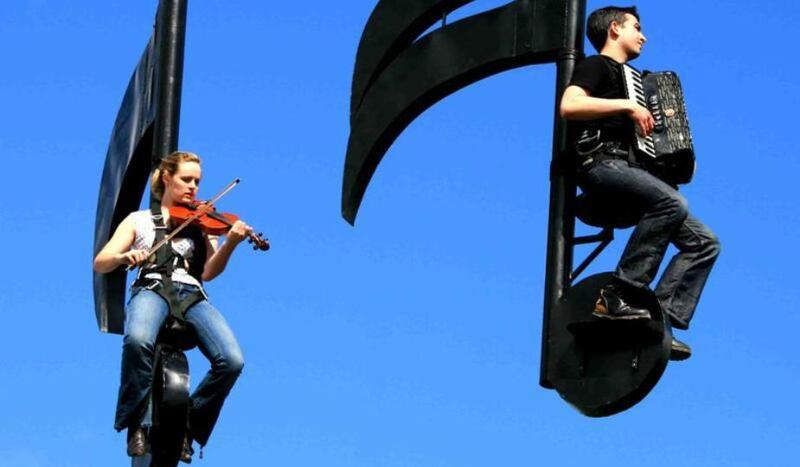Niamh Creely took up aerial dance she was "awestruck by the immense strength and skill needed to produce such graceful movements, but I was also excited by the possibilities that opened up by being able to move through the air".
Landfall, which she created with Jonathan Walsh, Aisling Ní Cheallaigh, and Arlene Caffrey, features four post-apocalyptic survivors suspended in a floating limbo above the audience's head.
“The ground has literally fallen away, and our set designer, Pauric Hackett, has found ingenious ways to make the different areas extensions of the four characters’ personalities. There’s a suspended garden, a floating window, a giant net that serves as a nest and an old lamp post that might still have some light to shed.”

Aerial dance emerged in the 1970s, as dancers experimented with low-flying trapezes, ropes and bungee cords. Early practitioners took procedures or “tricks” from circus arts and incorporated them into modern dance forms. Whereas circus arts emphasise the tricks, aerial dance is a seamless continuum of tricks and moves that is more concerned with the overall form than individual moments.
"Within aerial dance, there is the aesthetic of dance, which is different than the aesthetic of circus arts," says Nancy Smith, co-author of the book Aerial Dance and artistic director of Frequent Flyers Productions in Colorado. "But there is definitely a blurring of boundaries between dance and circus."
"Aerial performance, because of the risk involved, demands a heightened state of awareness that leads to an incredible Zen-like state of being in the moment," says Smith.
Existential danger
This existential danger is always present. Safety procedures are meticulous and accidents are rare. Yet, in 2008, tragedy struck Fidget Feet, the pioneers of aerial dance in Ireland, when performer Emma Insley died in a freak accident when rehearsing a show called Real Eyes.
Devastated, director Chantal McCormick and the rest of the company were supported by Insley's family, who encouraged the company to continue. Real Eyes was never performed, although some of its material is contained in their latest work, Fire Birds, which is dedicated to Insley's family.
“We have six Irish dancers beating the ground with their hard shoes and then getting lifted 40m through the air over the heads of the audiences,” says McCormick. “Music is from six drummers on a six-metre-high stage dressed in angel wings, and there are three red musical notes flying through the air with a family of three musicians,” she says.
Are her artistic ideas now stifled by safety concerns? “No, because we work very closely with riggers, designers and production managers. Whatever the idea, we can safely come up with a solution to make it work,” she says.
There is no dedicated space for aerial dance, so Fidget Feet is planning to open up an Aerial Dance Creation Centre in Westmeath, comprising a large studio and a smaller one. New Irish companies, such as Creely’s Ether Productions, show how Fidget Feet’s workshops are inspiring a new generation of aerial dancers.
“Dancers are pushing boundaries with what their bodies can do, inventing new and interesting aerial apparatus, finding new venues to perform and collaborating with other art forms,” says Smith.
An exciting future? “It’s taking off,” she says. “Pun intended.”
Landfall is at Project Arts Centre until Saturday. Fire Birds is at Derry Fleadh Cheoil on August 18











